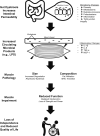Gut Microbiota Contribute to Age-Related Changes in Skeletal Muscle Size, Composition, and Function: Biological Basis for a Gut-Muscle Axis
- PMID: 29058056
- PMCID: PMC5858871
- DOI: 10.1007/s00223-017-0345-5
Gut Microbiota Contribute to Age-Related Changes in Skeletal Muscle Size, Composition, and Function: Biological Basis for a Gut-Muscle Axis
Abstract
Skeletal muscle is a highly plastic tissue that plays a central role in human health and disease. Aging is associated with a decrease in muscle mass and function (sarcopenia) that is associated with a loss of independence and reduced quality of life. Gut microbiota, the bacteria, archaea, viruses, and eukaryotic microbes residing in the gastrointestinal tract are emerging as a potential contributor to age-associated muscle decline. Specifically, advancing age is characterized by a dysbiosis of gut microbiota that is associated with increased intestinal permeability, facilitating the passage of endotoxin and other microbial products (e.g., indoxyl sulfate) into the circulation. Upon entering the circulation, LPS and other microbial factors promote inflammatory signaling and skeletal muscle changes that are hallmarks of the aging muscle phenotype. This review will summarize existing literature suggesting cross-talk between gut microbiota and skeletal muscle health, with emphasis on the significance of this axis for mediating changes in aging skeletal muscle size, composition, and function.
Keywords: Aging; Gut microbiota; Inflammation; Sarcopenia; Skeletal muscle.
Figures

References
-
- Guridi M, Tintignac LA, Lin S, Kupr B, Castets P, Ruegg MA. Activation of mTORC1 in skeletal muscle regulates whole-body metabolism through FGF21. Sci Signal. 2015;8:113. - PubMed
-
- Pedersen BK, Febbraio MA. Muscle as an endocrine organ: focus on muscle-derived interleukin-6. Physiol Rev. 2008;88:1379–1406. - PubMed
-
- Bortoluzzi S, Scannapieco P, Cestaro A, Danieli GA, Schiaffino S. Computational reconstruction of the human skeletal muscle secretome. Proteins. 2006;62:776–792. - PubMed
Publication types
MeSH terms
Substances
Grants and funding
LinkOut - more resources
Full Text Sources
Other Literature Sources

